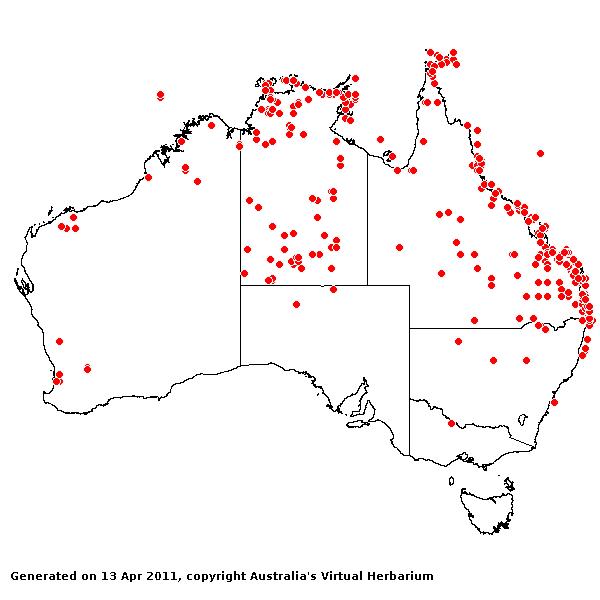Cenchrus echinatus* Steud. ex Doell,
in syn. Sp. Pl. 1050 (1753).
Classification. (GPWG 2001) : Subfamily
Panicoideae. Paniceae.
Type of Basionym or
Protologue Information: LT: Herb. van Royen, (L-912.356–116; ILT:
L). LT designated by Veldkamp in Jarvis et al., Regnum Veg. 127: 31 (1993); not
Hitchcock, Contr. U.S. Natl. Herb. 12: 127 (1908). ST: Dickinson s.n.,
Bermuda (BM-SL).
Key references
(books and floras): [1952] C.A.Gardner, Flora of Western Australia 1
Gramineae (286), [1981] M.Lazarides in J.Jessop (ed)., Flora of
Central Australia (479), [2002] D.Sharp & B.K.Simon, AusGrass,
Grasses of Australia, [2006] J.Jessop, G.R.M.Dashorst, F.M.James, Grasses
of South Australia (432), [2008] S.W.L.Jacobs, R.D.B.Walley &
D.J.B.Wheeler, Grasses of New South Wales (180).
Illustrations:
[1952] C.A.Gardner, Flora of Western Australia 1 Gramineae (287,
Pl. 83), [1984] N.T.Burbidge. rev. S.W.L.Jacobs, Australian Grasses (87), [2006] J.Jessop, G.R.M.Dashorst,
F.M.James, Grasses of South Australia (434, Fig. 363), [2008] S.W.L.Jacobs,
R.D.B.Whalley & D.J.B.Wheeler, Grasses of New South Wales, 4th edn
(180).
Habit. Annual
or perennial. Rhizomes absent or present. Stolons absent. Culms geniculately
ascending, 10–90 cm tall. Ligule a fringe of hairs, 0.8–1.4 mm long.
Leaf-blades 4–25 cm long, 3–10 mm wide.
Inflorescence.
Inflorescence solid, of only a few spikelets (spicate). Panicle linear, 2–10 cm
long. Racemes 2–10 cm long.
Spikelets.
Spikelets sessile, 2–3 in the cluster. Involucre composed of bristles, connate
into a cup below. Fertile spikelets 2-flowered, the lower floret barren (rarely
male), the upper fertile, comprising 1 basal sterile florets, comprising 1
fertile floret(s), without rachilla extension, ovate, dorsally compressed, 5–7
mm long.
Glumes. Glumes
thinner than fertile lemma. Lower glume ovate, membranous, without keels, 1
-nerved. Upper glume ovate, 3.8–5.7 mm long, membranous, without keels, 3–5
-nerved. Upper glume surface indumented. Florets. Basal sterile florets
1, barren, with palea. Lemma of lower sterile floret 100 % of length of
spikelet, membranous, 5 -nerved.
Fertile lemma 5–7 mm
long, without keel, 5 -nerved. Grain 3 mm long.
Continental
Distribution: Africa, Temperate Asia, Tropical Asia, Australasia, Pacific,
North America, and South America.
Australian
Distribution: Western Australia, Northern Territory, South Australia,
Queensland, New South Wales, Cocos Keeling Is, Ashmore Reef, Coral Sea Is.
Western Australia:
Gardner, Fitzgerald, Dampier. Canning, Carnarvon. Irwin, Drummond, Avon. Northern
Territory: Darwin & Gulf, Victoria River, Barkly Tableland, Central
Australia North, Central Australia South. South Australia: North-western.
Queensland: Burke, Burnett, Cook, Darling Downs, Gregory North,
Leichhardt, Maranoa, Mitchell, Moreton, North Kennedy, Port Curtis, South
Kennedy, Warrego, Wide Bay. New South Wales: North Coast.
Notes.
A widespread noxious weed, morphologically similar to and easily confused with C.
brownii. It generally has larger, wider-spaced burrs, straighter spines and
relatively small lower bristles.
Introduced; W.A.,
N.T., Qld, and N.S.W. In temperate rain forests, tropical and subtropical wet
sclerophyll forests, dry sclerophyll forests, Brigalow forests, tropical and
subtropical sub-humid woodlands, temperate sub-humid woodlands, semi-arid shrub
woodlands, arid and semi-arid low woodlands, shrub steppe shrublands, acacia
shrublands, eucalypt shrublands, arid tussock grasslands, arid hummock
grasslands, coastal grasslands, and tropical sub-humid grasslands. Flowers
sporadically throughout the year.




